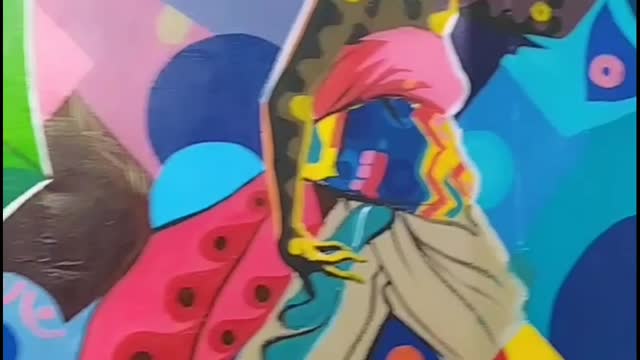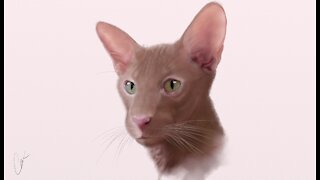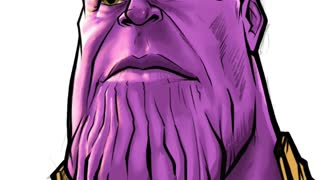Premium Only Content

Painting on wall (Mural).....speed work
In fine art, a mural is a painting on a wall or ceiling. Usually, it is either applied directly onto the surface, or painted on a canvas which is then fixed or cemented onto the wall. More rarely, it is painted onto panels that become part of the wall. Aside from the technical problems posed by the wall, there are numerous artistic issues to be overcome. To begin with, the mural painter needs to consider the viewpoint or angle from which his painting will be seen. While canvases are typically hung at or around eye-level, a mural is likely to be seen from several different angles. If so, there may be complex problems of perspective that need to be resolved. The wall painting should be flat and executed in matt paint, so that it can be viewed from different points and at any time of the day, without the glare of reflected light. In addition, it must be permanent, and it should suit its architectural environment and frame.
Interior Wall/Ceiling Mural Painting
Throughout classical antiquity, the Renaissance and Baroque eras and for centuries afterward, fresco was the traditional medium for murals. That said, from the 16th-century onwards, mural painters also used oil on canvas which was then fixed to the wall surface. The extra convenience was often cancelled out by a dullness of colour and more rapid deterioration. Today, while fresco still gives the best results, especially for indoor wall paintings, murals are mostly painted in oils, tempera or polymer colours.
The Revolution (c.1970)
Museo Nacional de Historia.
By David Alfaro Siqueiros, one of
the key figures in the 20th century
Mexican Renaissance of mural painting
ART APPRECIATION
See: Art Evaluation and also
How to Appreciate Paintings.
Note: Fresco is a method, where paint is applied onto freshly plastered walls or ceilings. There are three variants. "Buon" fresco involves painting in pigment combined with water on a thin layer of wet plaster, or lime mortar. "A Secco" fresco involves using dry plaster, except in this case a binding medium, like egg, glue or oil is needed to fix the pigment into the plaster. "Mezzo-fresco" involves painting onto almost-dry plaster - traditionally defined as firm enough not to leave thumb-prints - in a way that the colour pigments only penetrate slightly into the drying plaster. By the end of the 16th century this method had mostly replaced the buon fresco technique.
Exterior Mural Painting
With the growth of the urban landscape, and a corresponding rise in graffiti art, as well as political pressure groups, mural pictures on exterior walls in cities are becoming increasingly common. They too pose specific problems for the mural designer. Few surface paints exist with the durability required for outdoor murals, even in relatively dry climates. Which is why exterior wall paintings traditionally have been executed in coloured cement, mosaic tesserae (glass/ceramic), or tiles made out of terra cotta (See also the Portuguese Azulejo tile frescoes). Nowadays, outside murals which are painted directly onto walls can be protected with numerous layers of varnish or acrylic glaze. Alternatively, murals can be painted onto canvas or other types of ground and then applied to the final surface. Computer assisted techniques are also available, such as Frescography, a digital manufacturing method (CAM) created by Rainer Maria Latzke.
History of Mural Painting
The first mural designers were prehistoric cavemen who decorated their caves with a wide variety of cave painting. Famous examples can be seen at Chauvet Cave, Vallon-Pont-d'Arc, France (30,000 BCE); Lascaux Cave, Montignac, Dordogne, France (17,000 BCE) and Altamira Cave, Santillana del Mar, Spain (15,000 BCE), known as "the Sistine Chapel of Prehistoric Art".
Murals were among the most popular types of art in all classical civilizations, including those of Ancient Egypt (tombs), Minos (palaces), Ancient Greece (temples, domestic houses), Etruria (funeral art) and Ancient Rome (public institutions, domestic houses). (See also: Greek Mural and Panel Painting.) However, judging by the standard of murals found in houses excavated at Pompeii, Roman mural painters were little more than interior decorators. Murals were also a popular form of early Christian art, notably in the catacombs outside Rome.
Following the collapse of Rome in the 5th century, mural art disappeared from Europe altogether for several centuries, surviving only in Constantinople, the capital of the Eastern Roman Empire. The finest murals of Byzantine art, however, appeared as mosaic art in churches and mosques such as the Hagia Sophia (Constantinople), Ravenna Cathedral, St Mark's Cathedral Venice and others. (See also: Ravenna Mosaics.) Mural art also became popular in 10th century Kiev, where it was an important form of Russian medieval painting. For the top muralists and wall painters in Russia, see: Theophanes the Greek (c.1340-1410), Andrei Rublev (c.1360-1430), and Dionysius (c.1440-1502).
In western Europe, meanwhile the 11th and 12th centuries witnessed a major revival of murals during the period of Romanesque painting (c.1000-1200). For details of national styles see: Romanesque Painting in France and the more Islamic oriented Romanesque Painting in Spain.
-
 5:34
5:34
GinoArt
4 years agoSPEED PAINTING - GALAXY
105 -
 13:09
13:09
VioletYukiho Art
4 years agoSpeed Painting #004
833 -
 12:09
12:09
VioletYukiho Art
4 years agoSpeed Painting #003
322 -
 6:14
6:14
VioletYukiho Art
4 years agoSpeed Painting #002
381 -
 1:00
1:00
DawnArt
4 years agoSurf Bubbles Speed Painting
42 -
 1:10
1:10
CraxVangogh
4 years agoSpeed Painting Failure!
14 -
 15:14
15:14
MaplewoodBookArt
4 years agoCat Watercolor Painting Speed Painting Time Lapse
95 -
 2:25
2:25
Sweet Spot Design Co.
4 years ago $0.01 earnedThanos Speed Painting
19 -
 6:32
6:32
Sweet Spot Design Co.
4 years agoBruce Lee Speed Painting
52 -
 7:10
7:10
Marianne Scheel
4 years agoApple cake - Speed painting / Time-laps
22